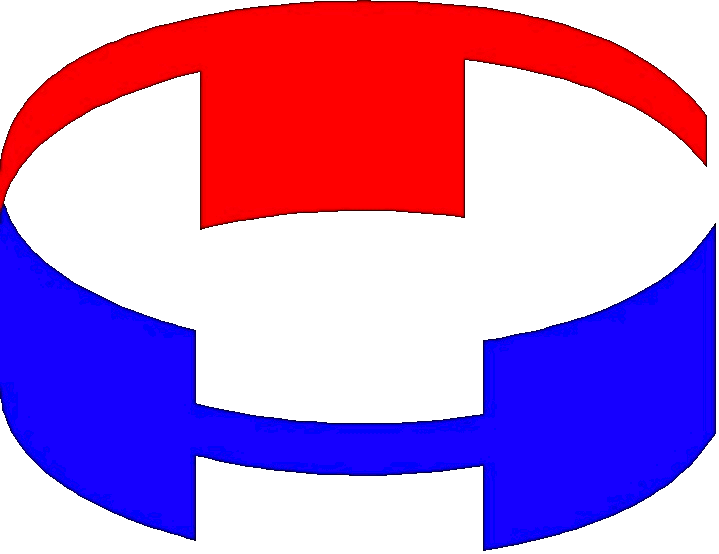
LDM "Long-term Deployment Module"
- The newly patented anti-fouling module from Hydrotech
- The most powerful anti-fouling (micro-fouling and macro-fouling) system in the market - "no gimmicks"
- No copper - no questionable chemicals
- Compatible with all existing multiprobes from all manufacturers
- Continuous deployment for one to three months in the worst conditions
- Guarantees stable and accurate measurements for all sensors
- Computer GUI will provide you with easy setup and maximum control flexibility
- Keeps sensors protected at all times during deployment
- SDI-12 ready
- Designed with all USGS needs in mind
- Can be used as an online underwater sampler with In-Situ measurement validated data
As you all know the Holy Grail of water quality is the prevention of biological fouling and its negative effect on the length of your multiprobe deployment and, therefore, your budget.
Over the years, several companies have tried to come up with solutions to this problem to no avail. To mention just a few: Copper mesh, copper guards, copper paint , and now copper tapes!
The anti-fouling effect of pure copper is indisputable. However, while pure copper prevents barnacles, mussels, shells, weed, and similar organisms ("macro-fouling") from settling, slime ("micro-fouling") forming on the surface may be promoting the macro-fouling. Adding co-biocides to anti-fouling paint, epoxy or tape may work against the forming of such slime. However, only a few such co-biocides are legally accepted. As of today, it is believed that only "Seanine" and "Irgarol" can be used in the USA, while "Omadin", "Preventol", "Zineb", "Seaning," and "Irgarol" (which probably is going to be banned by 2009) are allowed in most European waters. The situation is more liberal in other parts of the world, and in some regions co-biocides like "Chloro-thalonil" and "Diuron" meet no restrictions.
Copper coating has been used for more than 200 years as an effective anti-fouling agent on marine vessels. However, despite all efforts, it could not be used to protect water quality sensors from fouling, due to the fact that the anti-fouling properties of copper are only limited to a direct contact with its surface and the fact that the sensing element of all water quality monitoring sensors (like pH, Dissolved Oxygen, Redox, Turbidity, Selective Ions, and others) could not be coated or covered with copper. Therefore, copper use may keep the inert part of your unit clean, but it does not, in any way, shape, or form, protect the sensing element of each sensor from biological fouling or otherwise.
Wipers and brush devices for cleaning water quality sensors are also used on several multiprobes and do in fact stop mussels, shells, weed, and similar organisms ("macro-fouling") from settling on the sensing element. However, they do very little in stopping, removing, or prohibiting slime ("micro-fouling") from forming on the surface of the sensing elements.
Hydrotech has taken a completely different approach based on the following scientific facts:
1.Biological fouling (micro-fouling and macro-fouling) is directly connected to the presence of water.
2.Biological fouling (micro-fouling and macro-fouling) in water is proportional to the time sensors are exposed to water.
3.Biological fouling (micro-fouling and macro-fouling) is extremely reduced by the absence of light.
4.The actual operating time of a multiprobe is less than 10% of the deployment time.
Most environmental scientists and water quality monitoring specialists doing long-term monitoring are collecting data at set intervals ranging from a minimum of 15 minutes to an hour. The units are programmed in advance and set in the water. The sensors are continuously submerged in water during the deployment time. However, the operational time of the unit is less than 10% of the total deployment time. If the sensors can be removed from water and light during the 90% downtime, the biological fouling can be reduced by 90%.
Hydrotech ZS Consulting is very happy to announce the completion of a new Long-Term Deployment Module. We call it "LDM." The LDM is equipped with a water-sealed sampling chamber enclosing the sensing probes or sensors of the sensing device. When the LDM and the multiprobe connected to it are placed into water, water flowing into and out of the sampling chamber is controlled, such that water is present in the sampling chamber only during a relatively brief period of time when water quality measurements are taken by the probes. After the water quality measurements have been taken by the probes, the water sample is substantially pumped out of the sampling chamber so as to minimize the time during which the probes are in contact with the water being analyzed. The sensors are exposed to water for only 2 to 3 minutes each interval which guarantees a 90% to 95% reduction in biological fouling.
It's the fruit of four years of research and development, which concluded with the reward of patent number 7,437,248. For more information about the patent, visit the United States Patent Office at www.uspto.gov.
Specs:
- Outer diameter: 4.5”/11.43 cm
- Length without guard: 14”/35.56 cm
- Weight: 7.4 lbs/3.35 kg (typical)
- Computer Interface: RS-232 and SDI-12
- Operating Temperature: 1 to 50° C
- Maximum Depth: 25 feet / 7.62 m
LDM field test:
During the field test in Corpus Christi Bay in Texas, three Hydrolab units were deployed side by side:
- One DS5X with central wiping mechanism
- One standard DS5
- One standard DS5 with LDM
Below: After 2 weeks of deployment the units were retrieved from the water
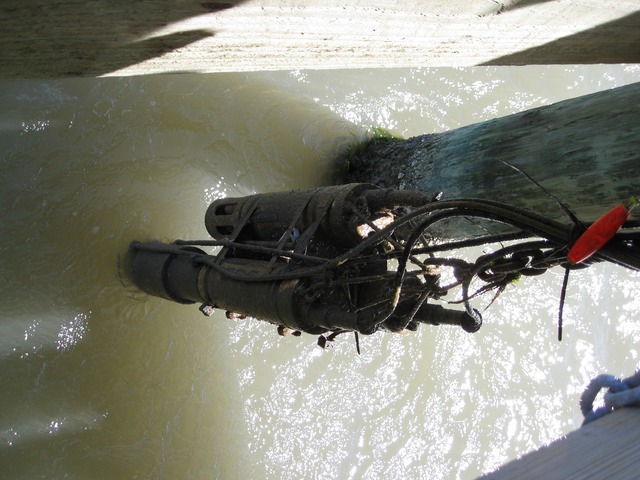
Below: A closer look at the sensors after 2-week deployments
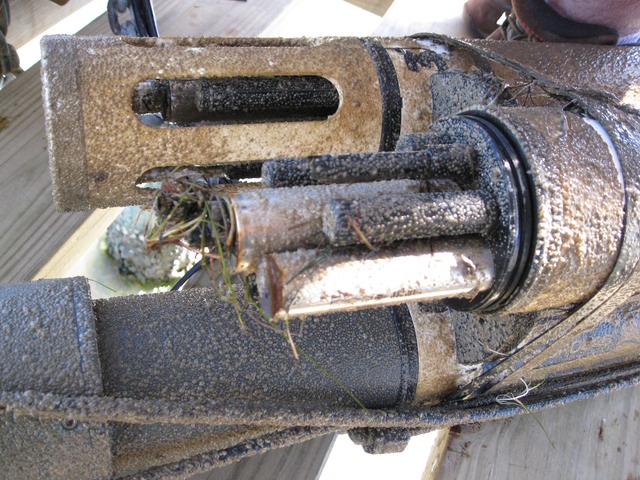
Below: A closer look at the LDM external casing after 2-week deployments
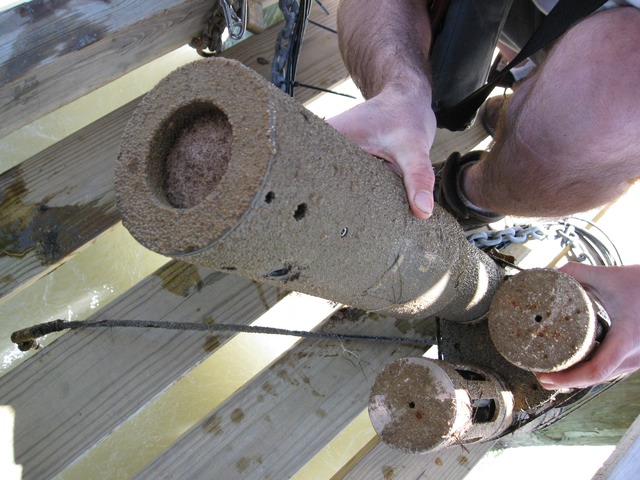
Below: sonde deployed with LDM
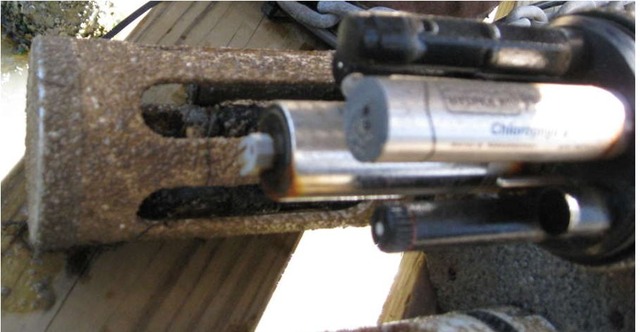
Below: picture of two YSI V2s deployed without and with LDM for 4 weeks in Corpus Christi Bay
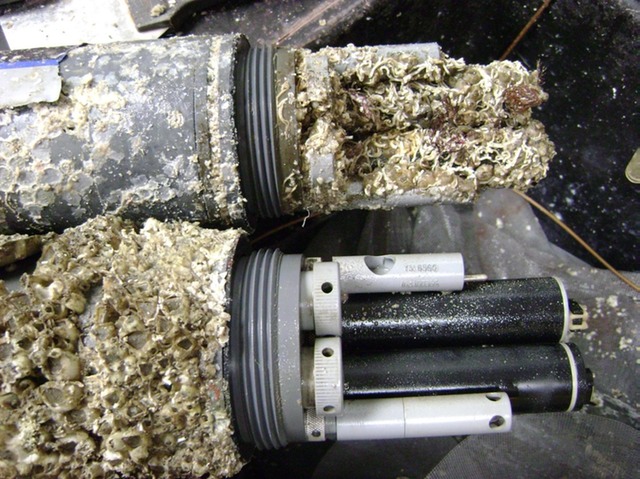
Most common questions and answers:
Q: Can the LDM be used with any multiprobe?
A: Yes. The LDM is designed to work with any multiprobe from any manufacturer. The sample housing is multiprobe specific but it's field replaceable.
Q: Does the LDM require external power?
A: Yes. The LDM requires a 12 Volts external power source.
Q: Does the LDM operate with data-loggers like Sutron and Handar?
A: Yes. The LDM can communicate to any data logger that uses SDI-12 or RS232 communication protocols.
Q: Can the LDM operate in waters with high sediments ?
A: Yes. The LDM has an optional sediment filter at the intake. The end user can use any type of filter based on the application
Q: Can the LDM be deployed at an angle ?
A: Yes, the LDM can be deployed up to a 20 Degree angle from the ground surface.
Q: What is the maximum depth deployment for the LDM?
A: 25 feet under water ( 7.62 m )
Q: How does the LDM work?
A: The LDM has a valve, a pump, and a controller board inside. A measurement cycle has three phases:
- Phase 1: Filling the sample housing. This is accomplished by opening a valve for a set duration inside the LDM. The hydrostatic pressure allows the water to flow via the intake through the valve then fill the sample housing.
- Phase 2: Holding the water in the sample housing. The valve is closed and the water inside the sample housing is held for set duration
- Phase 3: Emptying the sample housing. The pump turns on and pumps the water from the sample housing through the side tube to the surface.
Q: What is the dual tube on the side of the LDM used for?
A: One tube is used to vent the sample housing to the surface which allows the sample housing to fill using hydrostatic pressure only. The other tube is used to evacuate the water from the sample housing to the surface for data validation at the surface if needed.
Q: What materials are used in the LDM ?
A: All housings are built with Grey PVC. The cable jacket is Polyurethane, The connectors are 3/16 Stainless steel. Very safe.
Q: Can the LDM be used in fresh and salt water?
A: The LDM can safely be used in fresh, salt water, and any body of water that is compatible with PVC, Polyurethane, and 3/16 stainless steel
Q: are the LDM connectors waterproof?
A: The LDM under water connector is 100 % waterproof and designed to stay under water continuously. The DB9 surface connector is watertight only and cannot be submerged under water.
For a quote please email your request to sales or call 512-846-2893
